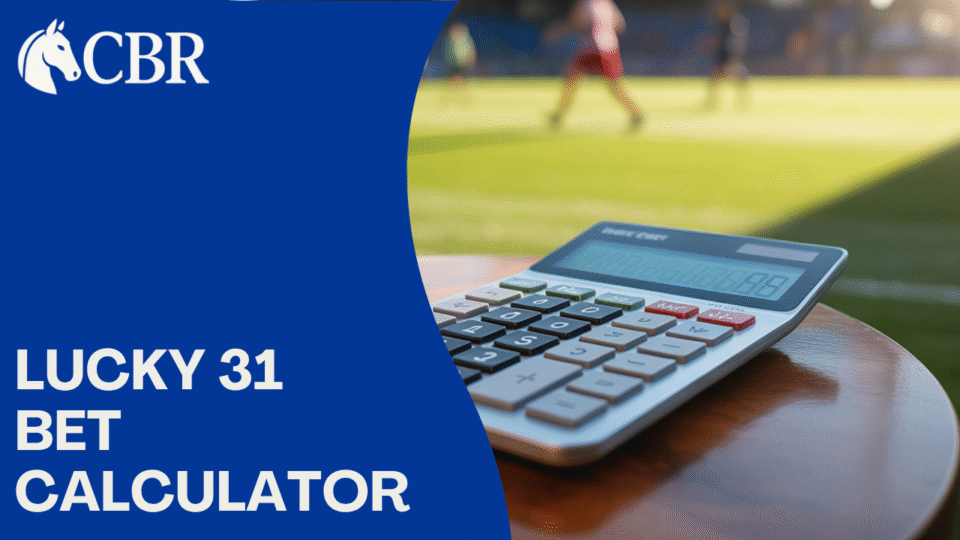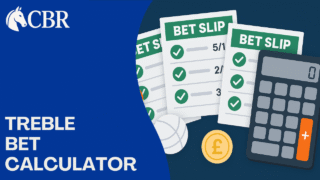A Lucky 31 bet calculator helps you accurately calculate your total stake, returns, and profit from 31 different bets on five selections. This means you can quickly understand the outcomes of singles, doubles, trebles, four-folds, and a five-fold accumulator within one wager. Using such a tool simplifies managing complex bets, so you avoid manual errors and save time.
The calculator also factors in bookmaker bonuses, Rule 4 deductions, and dead heats, which means your potential payouts are more precise. As a result, you get clearer insight into your betting strategy’s performance. You can enter odds and individual selection results, which lets you adapt the calculations to real-time events.
By using a Lucky 31 bet calculator, you improve decision-making because you know the exact figures before committing your stake. Therefore, it provides greater control over how you place bets across multiple events, especially on horse racing or greyhounds. This makes the calculator valuable for anyone who wants to maximise returns without confusion.
Contents
What Is a Lucky 31 Bet Calculator?
A Lucky 31 bet calculator simplifies the process of working out potential returns from a multiple bet that combines five selections into 31 bets. You can quickly assess how much you could win or lose based on different outcomes and your stake size. This tool helps you understand the detailed breakdown of bets and profits without manual calculation.
How Does the Lucky 31 Bet Calculator Work?
The calculator takes your five selections and the odds for each, then automatically calculates every possible combination of those selections. It computes the returns for singles, doubles, trebles, four-fold accumulators, and the five-fold accumulator where applicable. Since a Lucky 31 bet excludes singles, the calculator focuses on 31 bets made up of doubles and upwards.
It multiplies each bet’s stake by the odds and provides a total potential return. The calculator also deducts your total stake so you see the actual profit. You enter your unit stake once, and the calculator multiplies it by 31, showing you the full amount you are betting across all combinations.
Which Bets Are Included in a Lucky 31?
A Lucky 31 bet is made up of exactly 31 bets from your five selections. These are:
- 10 doubles: All pairs of selections combined
- 10 trebles: All combinations of three selections
- 5 four-fold accumulators: Groupings of four selections
- 1 five-fold accumulator: All five selections combined
There are no singles included, which means you need at least two winning selections to get a return. The multiple bet structure aims to spread your stake across different-sized accumulators to increase your chances of securing some payout.
Why Use a Lucky 31 Bet Calculator?
Using the calculator helps you avoid the complexity of manually adding 31 individual bets and their combinations. It provides a complete view of your potential return depending on how many selections win. This clarity allows you to make informed decisions about your stake size based on possible profits.
The tool also helps you experiment with different odds or outcomes before placing your bet. Since the total stake equals 31 times your unit stake, the calculator ensures you are aware of the total amount you are committing. It can also factor in special conditions like each-way betting and Rule 4 deductions, so your expected returns are as accurate as possible.
How to Calculate Lucky 31 Returns
Calculating the returns of a Lucky 31 bet involves several steps that require precise inputs and adjustments. You need to manage your selections and their outcomes, enter the correct odds while setting stakes accurately, and incorporate any bookmaker bonuses or adjustments like Rule 4 deductions. These steps ensure an accurate total return and profit calculation.
Entering Your Selections and Outcomes
Start by identifying your five selections, which must be from different events. For each selection, you decide the outcome: winner, loss, void, or dead heat. This outcome choice influences how your bets pay out, so it’s essential to be accurate.
You also need to specify the bet type for each selection, especially if applying each-way bets—this doubles your stake because it covers both win and place results. Properly entering void or dead heat outcomes adjusts the bet amounts or returns according to betting rules, preventing miscalculation of your total return.
Adding Odds and Adjusting Stake Per Bet
Input your odds in your preferred format: decimal, fractional, or American. Decimal odds are most common and easier for calculating returns directly. Once odds are entered, you set the stake per bet, which affects the total stake. In a Lucky 31, your total stake consists of 31 bets multiplying the individual stake.
Adjust your stake carefully to control how much money you want to place overall. The stake per bet determines potential profit and total returns, so even small changes here can significantly affect your outcome.
Accounting for Bonuses and Deductions
Include any applicable bookmaker bonuses like “all winner” enhancements or one winner consolation boosts. These bonuses increase your total return by a set percentage or multiply your returns based on the number of winners.
Apply Rule 4 deductions when a selection is withdrawn or a non-runner appears. These deductions reduce the odds and therefore your return to reflect the changed chances in the event, ensuring fair payout adjustments.
Both bonuses and deductions interact directly with your total payout. Accurately incorporating them means your total return and total profit are correctly represented, giving you a clear understanding of your Lucky 31 bet outcome.
Types of Bets Within a Lucky 31
A Lucky 31 bet consists of multiple bet types built from five selections, creating a combination of singles, doubles, trebles, four-fold accumulators, and a five-fold accumulator. This mix allows you to gain returns even if only some of your selections win, offering varied ways to profit.
Understanding Singles and Doubles
Singles are the simplest bet in a Lucky 31, consisting of one wager on each of your five selections. This means if one selection wins, you get a return from that single bet regardless of the other results. Singles provide a minimal stake exposure but ensure at least some chance of a payout.
Doubles combine two of your five selections into one bet, with ten possible double bets in total. If both selections in a double win, you receive a higher payout because the odds multiply. However, a loss in either selection means the double fails, so doubles carry more risk than singles but offer increased returns.
How Trebles and Four-Folds Work
Trebles involve grouping three of your selections into a single bet, which results in ten trebles within a Lucky 31. For a treble to pay out, all three selections must win, which increases potential returns significantly compared to doubles. Trebles create more chances to win higher amounts but require multiple winning picks.
Four-fold accumulators combine four different selections into one bet, generating five such bets in the Lucky 31. Each four-fold requires all four selections to win, pushing returns higher than trebles or doubles because the odds multiply across four outcomes. The risk increases as the number of selections betting on grows, but so does the potential payout.
The Role of the Five-Fold Accumulator
The five-fold accumulator is the single bet combining all five selections into one wager. It pays out only if every single pick wins, which makes it the highest-risk bet in a Lucky 31. However, it offers the largest potential return because the odds of all five selections multiply together.
This accumulator ties the whole Lucky 31 together, creating the ultimate prize when successful. Despite its risk, the five-fold accumulator is critical because its payout can substantially increase your overall returns, especially if several other bets within the Lucky 31 also succeed.
When and Why Should Punters Use a Lucky 31 Bet Calculator?
Using a Lucky 31 bet calculator helps you manage the complexity of multiple selections efficiently. It gives clear insight into how your stake is spread and highlights how potential returns and total profit change based on different outcomes.
Strategic Betting Decisions
You should use a Lucky 31 calculator before placing your bet to understand the full cost of your total stake, which covers 31 individual bets involving singles, doubles, trebles, four-folds, and a five-fold accumulator.
Calculating potential returns for each selection enables you to spot value bets and adjust stakes accordingly. The calculator considers each-way bets and Rule 4 deductions, so your decisions reflect realistic returns rather than assumptions.
By previewing profit and loss across scenarios, you avoid surprises and can tailor your selections to maximise efficiency. This means you can focus on combinations that deliver more favourable outcomes rather than guessing blindly.
Reviewing Results and Profits
After events conclude, the calculator allows you to input actual outcomes, including wins, losses, voids, or dead heats, which helps you accurately tally your total profit.
It breaks down how much came from individual bets and accumulators, so you understand which parts of your Lucky 31 contributed most to your overall return. This transparency supports better future betting strategies.
You can also include bookmaker bonuses and enhancements, adjusting your review for special offers that affect total returns. This detailed summary ensures you have a precise picture of how your stake transformed after all selections settled.
Lucky 31 Bets in Horse and Greyhound Racing
The Lucky 31 bet is popular in sports with fixed-odds betting due to its coverage of multiple bet types from five selections. It increases your chances of return by combining singles, doubles, trebles, four-folds, and a five-fold accumulator. The bet’s structure makes it appealing where multiple selections often run simultaneously, such as in horse and greyhound racing.
Popularity in Horse Racing
Horse racing is synonymous with the Lucky 31 bet because of the sport’s many races and varied competitors. You can place five separate bets across different races or within one meeting, which suits the accumulation feature. Bookmakers often add bonuses, like a 20% return boost for all winners, encouraging you to use Lucky 31 bets here.
Race outcomes tend to fluctuate due to form, track conditions, and jockey performance, so the spread across singles to accumulators helps secure partial wins. The singles part means even if just one horse wins, you receive some return, creating a safety net that differentiates Lucky 31 bets from pure accumulator bets.
Applying Lucky 31 to Greyhound Racing
Greyhound racing shares similarities with horse racing that make Lucky 31 bets effective. The frequent races and short intervals allow you to place bets on a mix of dogs in multiple heats. Your five selections cater well to greyhound racing’s fast-paced nature, providing chances for singles as well as combinations.
While greyhound races are shorter and often less predictable than horse races, the Lucky 31 format compensates by spreading your stake across 31 bets. This bet structure supports differing odds and outcomes, enabling payouts even if some dogs underperform. Some betting sites specifically allow Lucky 31 bets on greyhound racing, often with similar bonuses to horse racing to reward multiple winners.
Comparison With Other Bet Calculators
Understanding how the Lucky 31 bet calculator contrasts with similar tools helps you choose the most suitable calculator for your needs. Key differences emerge in bet complexity, stake calculation, and the number of combinations involved. These factors influence potential returns and how much you commit per bet.
How Does Lucky 31 Differ From Lucky 15 and Yankee Bets?
The Lucky 31 bet involves 5 selections and 31 bets, which is more than the Lucky 15 and Yankee bets. A Lucky 15 covers 15 bets from 4 selections, while a Yankee includes 11 bets from the same number of selections. This increase means your total stake is 31 times your unit stake for the Lucky 31, making it significantly more expensive.
Lucky 31 bets give you more coverage with singles, doubles, trebles, four-folds, and a five-fold accumulator. This structure increases your chance of returns but requires a higher total stake. Lucky 15 calculators and Yankee calculators calculate odds and returns based on fewer combinations and thus require less capital but limit bet variety.
You should expect the Lucky 31 calculator to handle more complex permutations automatically, which can simplify decision-making compared to using a separate Lucky 15 or Yankee calculator.
Overview of Patent and Yankee Calculators
Patent calculators work on 3 selections, producing 7 bets including singles, doubles, and a treble. They are simpler than Lucky 31 calculators and cost just 7 times the unit stake. You might use a patent calculator if you want minimal combinations with guaranteed multiple bet types.
Yankee calculators compute 11 bets based on 4 selections, without singles. This reduces the number of bets but maintains coverage on doubles, trebles, and four-folds. The Yankee calculator is cheaper than Lucky 31 but offers fewer combinations because it excludes singles.
Both patent and Yankee calculators cater to smaller bet slips and lower stakes. Using them means quicker calculations and simpler stake control compared to the Lucky 31 calculator, which must handle a broader set of combinations and bets.
| Bet Type | Number of Selections | Total Bets | Max Stake Multiplier | Includes Singles |
|---|---|---|---|---|
| Patent | 3 | 7 | 7 | Yes |
| Yankee | 4 | 11 | 11 | No |
| Lucky 15 | 4 | 15 | 15 | Yes |
| Lucky 31 | 5 | 31 | 31 | Yes |
Choosing between these calculators depends on your preferred number of selections, bet complexity, and how much stake you plan to commit. The Lucky 31 calculator offers the broadest bet coverage but at a higher cost.
Conclusion
Using a Lucky 31 bet calculator simplifies complex calculations, allowing you to quickly determine potential returns and profits from your selections. This tool works efficiently because it accounts for multiple bet types, such as singles, doubles, trebles, and accumulators, ensuring you get an accurate overview without manual effort.
You benefit from clear insights as the calculator factors in bonuses, concessions, and Rule 4 deductions, which affect your final payout. This precision means you can make informed choices before placing your bets. The ability to adjust stakes and outcomes based on your selections gives you greater control over your betting decisions.
Relying on such a calculator also saves valuable time, especially when managing multiple bets or changing odds. By using it regularly, you increase your understanding of potential returns and minimise errors caused by manual calculation.
To maximise your betting approach, use a Lucky 31 calculator before committing any stake. This helps you plan your wagers logically and track your bets consistently, promoting smarter play while managing your budget effectively.





